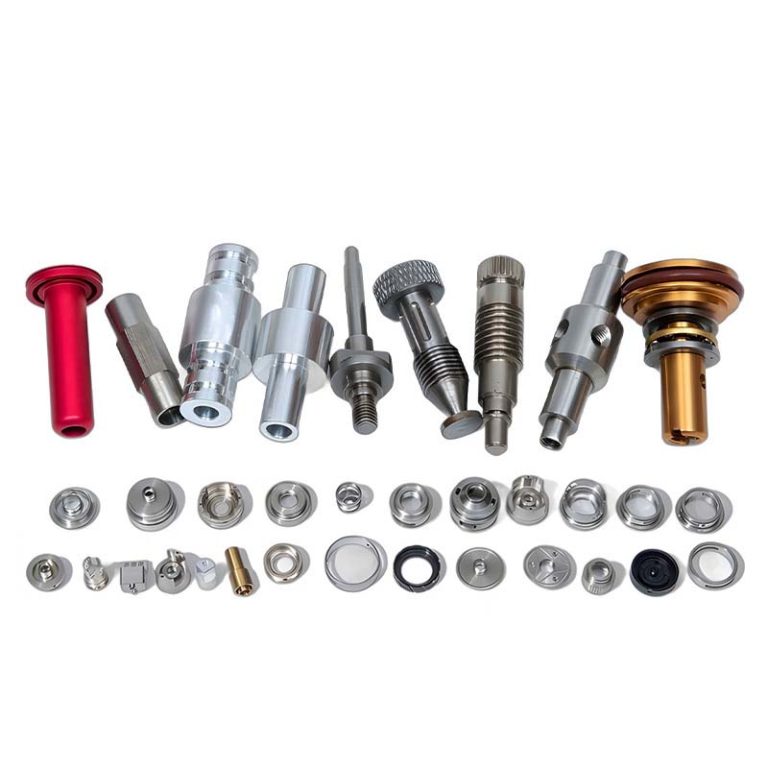Computer Numerical Control (CNC) machining represents a paradigm shift in manufacturing, transcending mere fabrication to become a sophisticated algorithmic process that sculpts raw materials into exquisitely precise metal components. This isn't simply the automated creation of parts; it's the orchestration of a complex interplay between sophisticated software, high-precision tooling, and the inherent properties of the metal itself – a dynamic system yielding results far exceeding the capabilities of traditional methods. The impact resonates across diverse sectors, from the aerospace industry's relentless pursuit of lightweight, high-strength alloys to the intricate demands of micro-manufacturing in the biomedical field.
Beyond the superficial notion of automated cutting, CNC machining embodies a profound understanding of material science, thermodynamics, and even chaos theory. The seemingly deterministic nature of the process belies a subtle dance between programmed instructions and the unpredictable realities of material behavior. Minute variations in temperature, tool wear, and even the ambient environment can subtly influence the final product, demanding a level of expertise that goes beyond mere programming proficiency. Mastering CNC machining requires a deep understanding of these subtle interactions, a skill honed through years of experience and a keen eye for detail.
The evolution of CNC machining is a testament to humanity's relentless pursuit of precision. Early iterations, hampered by the limitations of nascent computing power and relatively crude control systems, laid the groundwork for today's highly sophisticated systems. Modern CNC machines, capable of sub-micron accuracy and intricate multi-axis movements, represent a culmination of decades of engineering innovation. This evolution isn't merely incremental; it's a qualitative leap, pushing the boundaries of what's physically achievable in metal fabrication. The resulting components – intricate, dimensionally perfect, and often possessing functionalities beyond the scope of human craftsmanship – are the lifeblood of countless industries, underpinning technological advancements across the board. The future of CNC machining lies not just in further miniaturization and increased speed, but in the integration of predictive modeling and artificial intelligence, promising a level of control and precision previously relegated to the realm of science fiction.
Deconstructing the Algorithmic Heart of CNC Machining
CNC machining, far from a simple process, represents a sophisticated interplay of algorithmic control, material science, and high-precision mechanics. It's a symphony of controlled chaos, where seemingly random movements of cutting tools, guided by intricate digital instructions, yield components of breathtaking accuracy and complexity. The underlying principle is deceptively simple: translate a digital design into a series of precisely executed movements, but the execution demands a nuanced understanding of several interwoven disciplines.
Beyond Precision: Unveiling the Algorithmic Underpinnings
The "magic" lies not in the machine itself, but in the intricate dance between the CAD model and the CNC controller. The CAD model, a digital representation of the desired component, is not merely a blueprint; it's a meticulously crafted instruction set, a complex algorithm translated into G-code, the language spoken by the CNC machine. This G-code dictates every microscopic movement of the cutting tool, every fractional change in speed and feed rate, every subtle adjustment to compensate for tool wear and material properties. The seemingly simple act of machining becomes a complex optimization problem, balancing speed, precision, and tool life in a dynamic interplay.
Material Selection: A Critical Determinant of Success
The choice of material transcends simple material properties; it's a strategic decision influencing every aspect of the machining process. Aluminum, with its machinability and lightweight nature, contrasts sharply with the demanding properties of titanium, requiring specialized tooling and significantly altered cutting parameters. Acero, in its myriad forms, presents a spectrum of challenges, ranging from readily machinable alloys to hardened steels demanding extreme cutting forces and specialized tool geometries. The selection process is not merely about choosing a material; it's about selecting a material y a process, a carefully calibrated interaction between material properties and machining parameters.
The Machining Process: A Controlled Descent into Chaos
The seemingly linear process of CNC machining is, in reality, a dynamic feedback loop. The initial CAD model serves as the starting point, but the actual machining process involves continuous adjustments based on real-time sensor data. Sensors monitor tool wear, cutting forces, and even the subtle vibrations of the machine itself. This data feeds back into the control system, allowing for dynamic adjustments to maintain precision and prevent catastrophic failures. The process is not merely subtractive; it's a constant negotiation between the programmed instructions and the unpredictable realities of material behavior and machine dynamics.
Advanced Techniques: Pushing the Boundaries of Precision
Beyond basic milling y turning, advanced CNC techniques blur the lines between subtractive and additive manufacturing. Multi-axis machining allows for the creation of complex, free-form shapes previously unimaginable. Live tooling, incorporating rotating tools on the moving spindle, enables simultaneous machining of multiple surfaces, drastically reducing cycle times. The integration of robotics and artificial intelligence further pushes the boundaries, enabling autonomous operation, adaptive control, and unprecedented levels of precision and efficiency. CNC machining is not a static technology; it's a constantly evolving field, driven by the relentless pursuit of greater precision and efficiency. The future of CNC machining lies not in incremental improvements, but in fundamental shifts in our understanding of algorithmic control and material behavior.
The Algorithmic Precision of CNC Machining: A Deep Dive into Tolerances, Testing, and Technological Frontiers
The relentless pursuit of micron-level accuracy in CNC machining transcends mere fabrication; it's a testament to humanity's capacity for precise control over the material world. This precision, often expressed in tolerances measured in fractions of a millimeter, is not merely a technical achievement but a fundamental requirement across diverse sectors where even minuscule deviations can cascade into catastrophic failures. The aerospace industry, for instance, demands tolerances so stringent that a single micron's error can compromise the structural integrity of a critical component, potentially resulting in catastrophic consequences. This necessitates a rigorous, multi-layered approach to quality assurance, far exceeding simple dimensional verification.
Beyond Dimensional Fidelity: A Multifaceted Quality Assurance Paradigm
Traditional quality control methods, while valuable, are insufficient for the demands of modern CNC machining. The implementation of advanced metrology, encompassing coordinate measuring machines (CMMs) with sub-micron resolution, laser scanning systems for complex geometries, and advanced optical techniques, is paramount. However, dimensional accuracy is only one facet of the quality assurance puzzle. Surface finish analysis, employing techniques like profilometry and atomic force microscopy, is crucial for determining the micro-roughness and its impact on component performance, particularly in applications demanding low friction or high wear resistance. Furthermore, the incorporation of statistical process control (SPC) and robust design of experiments (DOE) methodologies allows for proactive identification and mitigation of process variability, minimizing the risk of defects and ensuring consistent output quality. This proactive approach extends to destructive testing, where carefully selected samples undergo rigorous analysis to validate material properties and structural integrity under extreme conditions.
Industrial Applications: Beyond the Obvious
The ubiquity of CNC-machined components belies their profound impact. While applications in aerospace, automotive, and medical sectors are well-documented, the true extent of their influence extends far beyond these established domains. Consider the intricate micro-fluidic devices used in advanced medical diagnostics, the high-precision components in semiconductor manufacturing equipment, or the complex geometries found in cutting-edge robotics. These applications demand not only exceptional dimensional accuracy but also stringent material selection and surface treatments to withstand extreme operating conditions. The relentless miniaturization of electronic components, for example, necessitates the creation of increasingly intricate and delicate parts, pushing the boundaries of CNC machining capabilities.
The Future of Precision: Technological Convergence and Unforeseen Challenges
The future of CNC machining is inextricably linked to technological convergence. The integration of artificial intelligence (AI) and machine learning (ML) algorithms promises to revolutionize process optimization, enabling real-time adjustments and predictive maintenance. Additive manufacturing (3D printing) techniques, when integrated with subtractive CNC machining, open up new possibilities for creating complex hybrid components with unparalleled design flexibility. The exploration of advanced materials, including high-strength alloys, ceramics, and composites, further expands the potential of CNC machining. However, this progress is not without challenges. The increasing complexity of components and the demand for ever-higher precision necessitate a corresponding increase in the sophistication of quality control methodologies and the development of new metrology techniques capable of characterizing these advanced materials and geometries. The journey towards perfect precision is an ongoing process, a continuous interplay between human ingenuity and technological advancement.
The Algorithmic Leviathan: CNC Machining's Evolving Symbiosis with Sustainability and Technological Singularity
The CNC machining industry, once a bastion of brute force and material profligacy, now finds itself entangled in a complex, and arguably paradoxical, dance with sustainability. The imperative for environmental responsibility, far from being a peripheral concern, is rapidly becoming a core algorithmic constraint, shaping the very architecture of production. High-speed machining, while superficially appearing as a solution to material waste, presents a double-edged sword: increased efficiency necessitates a corresponding surge in energy consumption, demanding a holistic reassessment of the entire lifecycle—from raw material sourcing to end-of-life management of components. The adoption of "eco-friendly" coolants and lubricants, while laudable in intent, often introduces unforeseen complexities: biodegradability may compromise performance, demanding a constant recalibration of the delicate balance between environmental impact and manufacturing efficacy. This is not merely optimization; it's a struggle for survival within a rapidly evolving regulatory landscape.
The Technological Singularity of Precision Manufacturing: Beyond VR/AR
The future of CNC machining transcends the simplistic narrative of incremental improvement. The convergence of virtual and augmented reality (VR/AR), while offering enhanced visualization and programming, is merely a prelude to a more profound transformation. Additive manufacturing, far from being a supplementary technology, is poised to become a disruptive force, challenging the very foundations of subtractive machining. The creation of complex, hybrid metal components—a fusion of additive and subtractive processes—heralds an era of unprecedented design freedom, but also necessitates a radical rethinking of quality control and material science. Predictive maintenance, powered by the Internet of Things (IoT) and fueled by the ever-growing torrent of machine data, is evolving from a reactive measure to a proactive, almost precognitive, capability, anticipating failures before they occur and optimizing production flows with an unnerving efficiency. This is not merely Industry 4.0; it's the nascent stage of a fully interconnected, self-regulating manufacturing ecosystem.
The Indispensable, Yet Evolving, Role of CNC Machining
CNC machining is no longer a mere component of modern industry; it is the very sinew and bone of technological advancement. From the micro-precision of horological marvels to the macro-scale engineering of aerospace components, its impact is pervasive and profound. The precision-crafted metal parts it produces are not merely functional; they are the embodiment of human ingenuity, a testament to our capacity to shape matter with unprecedented accuracy and control. However, this power demands responsibility. The industry's continued evolution is not simply about enhancing precision and efficiency; it's about navigating the treacherous terrain of sustainability, technological singularity, and the ethical implications of increasingly autonomous manufacturing systems.
The Unfolding Narrative of Precision and Sustainability
The future of CNC machining is not a predetermined trajectory; it is a dynamic, unpredictable narrative unfolding in real-time. The integration of artificial intelligence (AI), far from being a futuristic fantasy, is already transforming design processes, optimizing toolpaths, and enabling unprecedented levels of automation. This, however, brings forth profound questions regarding job displacement, algorithmic bias, and the very definition of human expertise within the manufacturing process. The journey towards greater precision and efficiency is inextricably linked to the pursuit of sustainable manufacturing practices. The metal miracles of CNC machining will continue to shape our world, but the nature of that shaping—its ethical dimensions, its environmental consequences, and its societal impact—remains a subject of ongoing, and often unsettling, debate.

